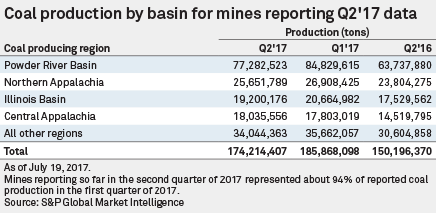US Coal Production Slides Again in Quarter Two of 2017, According to Early MSHA Data

By Taylor Kukendall, Ashleigh Cotting
July 20, 2017 - Many of the largest U.S. coal mines continued to throttle down production in the second quarter of 2017 following a brief production surge that began in the last half of 2016.
Coal production is down 11.7 million tons, or 6.3%, in the second quarter compared to the prior quarter among producers who reported data that has been published by the U.S. Mine Safety and Health Administration so far. The declines were seen across most major basins, though the hardest-hit region by volume — at 7.5 million tons — was the Powder River Basin. Producers reporting from Central Appalachia so far produced about 232,537 tons more coal than in the prior quarter.

Full coal mine production data showed a 1.3% drop in coal mined from the fourth quarter of 2016 to the first quarter of 2017, a trend that appears to have accelerated in the second quarter after bouncing off of record lows. The S&P Global Market Intelligence analysis is based on SNL Energy data as of July 19 and analyzes coal mines that have reported production in the second quarter of 2017. The mines accounted for 94% of total coal production in the first quarter.
A recent analysis of U.S. Energy Information Administration data showed that while underlying fuel price trends favored a shift to coal following a year in which natural gas dominated electricity generation, current forward prices suggest that the year-over-year shifts seen in the first half of 2017 will not be as dramatic for the full year. The industry also saw a year-over-year 58% rise in coal exports in the first quarter of 2017.
Despite the dip in coal mined in the second quarter, total U.S. production remained 16.0% higher than a year ago in the second quarter among reporting mines. The year-ago quarter is the bottom of a coal market cycle that saw production steadily decline before accelerating in 2015.

Average U.S. coal mining employment at the reporting mines continues to rise despite a drop in overall production. The increase in production from Central Appalachia mines paired with increased overall employment suggests coal companies may be going after more labor-intensive production as international pricing for metallurgical coal has improved.
Average coal mine employment at the reporting mines was up about 1.7%, or 829 jobs. While there have been a few reports of difficulty finding miners as mines ramp up in response to international markets, the increases in employment remain about 28.9% lower than levels seen as recently as the second quarter of 2012 at those mines. A flurry of mine openings in June primarily featured metallurgical coal mines, though at least one coal company, Paringa Resources Ltd., is aiming to be the first thermal coal mine to roll out under President Donald Trump's administration.
Even with a friend in the White House, as promised by Trump administration officials, the recently reorganized coal sector faces numerous obstacles, including low natural gas prices, an aging coal fleet and competition from renewable energy.

Some of the country's largest coal mines drastically cut production in the second quarter. Of the top 10 coal mines reporting production, seven reported reduced volume.
Peabody Energy Corp. reported that production from the North Antelope Rochelle mine decreased 9.3% quarter-to-quarter to 22.7 million tons. Arch Coal Inc. reduced production at Black Thunder by 14.1% to 15.7 million tons. The two Powder River Basin mines account for 22.0% of U.S. coal production reported so far.
Other large mines including operations owned by Cloud Peak Energy Inc., Contura Energy Inc. and NACCO Industries Inc. also reported declines in production quarter to quarter. Larger mines that increased coal production include Peter Kiewet and Sons Inc.'s Buckskin mine, Cloud Peak's Spring Creek mine and the Bailey mine operated by CONSOL Energy Inc.'s master limited partnership CNX Coal Resources LP.
Of the top 10 mines reporting so far, only Contura Energy's Eagle Butte mine reduced year-over-year production in the recent period.

